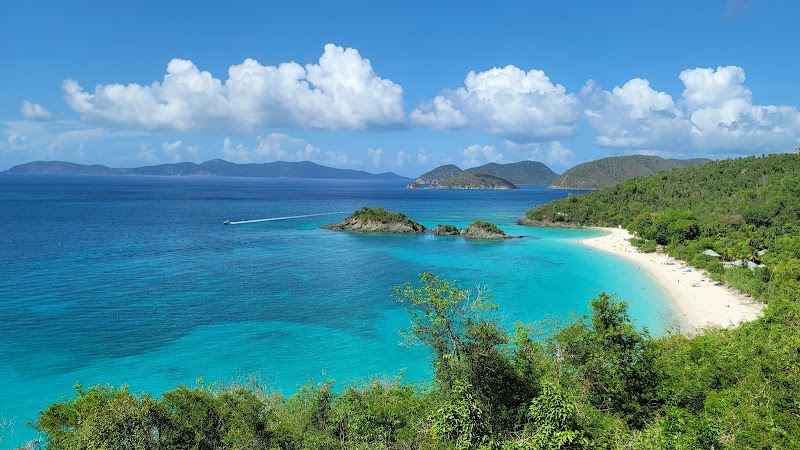Beyond Cinnamon and Trunk Bay: Top Beach and Waterfall Hikes in Virgin Islands National Park
Escape the crowds at Cinnamon and Trunk Bay by tackling the Virgin Islands National Park’s lesser-known beach and waterfall hikes. These trails combine tropical forests, rugged coastline, and hidden cascades, providing fresh perspectives on one of the Caribbean’s most beautiful and dynamic landscapes.
Hydrate Often and Carry Extra Water
Island heat and humidity can drain you faster than expected. Plan to drink at least one liter per hour during hikes and carry more than you think you’ll need.
Wear Durable Footwear with Good Grip
Trails include rocky and slippery terrain. Closed-toe shoes or sturdy sandals with traction reduce the risk of slips and protect from sharp coral or roots.
Start Early or Late to Avoid Midday Heat
The Caribbean sun climbs quickly and intensely. Plan your hikes for early morning or late afternoon to enjoy cooler temperatures and better lighting.
Use Reef-Safe Sunscreen and Pack Light
Protect the delicate marine environment by choosing eco-friendly sun protection, and keep your pack minimal to stay nimble on varied terrain.
Beyond Cinnamon and Trunk Bay: Top Beach and Waterfall Hikes in Virgin Islands National Park
Virgin Islands National Park offers more than its famous sun-soaked shores at Cinnamon and Trunk Bay. Venture off well-trodden paths to discover coastal trails where turquoise waters crash against limestone cliffs and hidden waterfalls that invite a refreshing pause. These hikes range from breezy beach walks to more rugged explorations, each promising a dynamic dialogue with the island’s fiercely independent nature.
Start your journey on the Reef Bay Trail, a 3.4-mile loop that sweeps from seaside to forest with an elevation gain of about 400 feet. The path threads under a canopy of tropical hardwoods, their leaves whispering above as the bay’s salty breath pushes forward at the trail’s end. Here, a waterfall plunges into a natural pool daring you to step closer. Bring sturdy shoes: rocky, sometimes slippery sections knead your footing, while occasional roots grasp at boots like the forest itself is testing resolve.
If you seek balance between effort and reward, Lameshur Bay offers two distinct trails — the Lameshur Bay Trail and Johnny Horn Trail — that deliver remote beaches framed by coral reefs. These moderate trails stretch roughly 2 miles one-way with gentle climbs and sandy stretches, meeting the water where currents twirl in celebration. The sun presses heavy, so timing your trek early morning or late afternoon offers cooler air and deeper shadows for shade.
For a quieter experience, the Francis Bay Trail leads to a remote beach framed by hidden coves and dramatic rock formations. It’s a short 1.2-mile walk, relatively flat but with rugged shoreline footing that challenges balance. The ocean insists with a crashing soundtrack, as waves toss and retreat, marking the rhythm of your footfall on the edge of the wild.
Preparation is key: the Virgin Islands’ heat and humidity demand careful hydration—carry more water than you think. Waterproof footwear or sandals with firm grip handle wet rocks and tidal pools. Timing your hike to avoid the midday sun isn’t just comfort; it’s safety. Pack light, bring reef-safe sunscreen, and keep your camera ready—the island frames moments of raw, unfiltered beauty unique to each trail.
Each trail is a conversation with an environment that's fiercely itself, presenting challenges and moments of stillness. The payoff lies not just in isolated beach arrivals or waterfall encounters but in every step inside this force. These hikes go far beyond postcards; they invite you to listen and respond, to move alongside the living character of Virgin Islands National Park.
Nearby Trips
All Adventures
Boat Charters
Water Activities
Adventures near Charlotte Amalie
Discover the unique and memorable adventures that make Charlotte Amalie special.
Frequently Asked Questions
Are the Reef Bay and other waterfall trails safe for swimming?
Yes, the natural pools beneath the waterfalls on Reef Bay can be refreshing spots. However, currents can be strong after rains, so always assess water conditions before entering.
Is there cell phone reception on these hikes?
Reception is spotty or nonexistent on most trails beyond the main beach areas. Prepare accordingly with offline maps and let someone know your plans.
Can I camp overnight near these trails?
Camping is allowed only at designated areas within Virgin Islands National Park with proper permits. Backcountry camping near trails like Reef Bay requires coordination with park rangers.
What wildlife might I encounter on these hikes?
Expect to see the endangered Lesser Antillean Iguana, various tropical birds like bananaquits and the Caribbean elaenia, and occasionally mongoose along trails.
Are dogs or pets allowed on the trails?
Pets are not allowed within Virgin Islands National Park to protect native species and habitats.
How do tides affect beach access on these trails?
Tides can expose or cover rocky sections near shorelines, especially on Lameshur Bay. Check tide charts before planning beach-focused hikes for easier passage.
Recommended Gear
Trail Shoes or Sturdy Hiking Sandals
Provides traction and foot protection on mixed surfaces, including slippery rocks and roots.
Reusable Water Bottle with Filter
Important for hydration and maintaining water supplies on longer hikes.
Lightweight Rain Jacket
Protects against sudden tropical rain showers common in warmer months.
Sun Hat and Reef-Safe Sunscreen
Shield your skin from harsh sun while preserving the delicate marine environments.
Local Insights
Hidden Gems
- "Lameshur Bay’s coral reef snorkeling just off the trail’s end"
- "Old sugar mill ruins visible along the Reef Bay Trail"
- "Secret coves near Francis Bay with tide pools teeming with marine life"
Wildlife
- "Lesser Antillean Iguana"
- "Caribbean Elaenia (bird species)"
- "Hermit crabs and reef fish along coastal sections"
History
"The trails pass through areas once inhabited by the Taíno people and later cultivated during the colonial sugar trade era. Remnants of stone walls and old plantations dot the forest."

